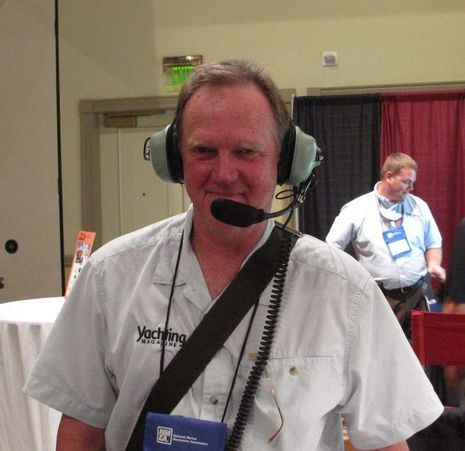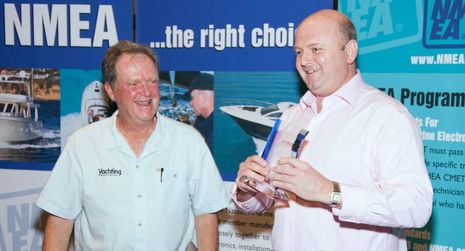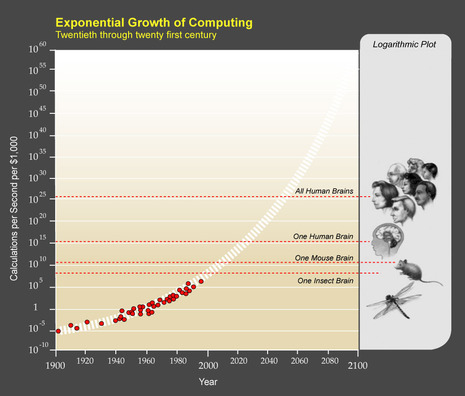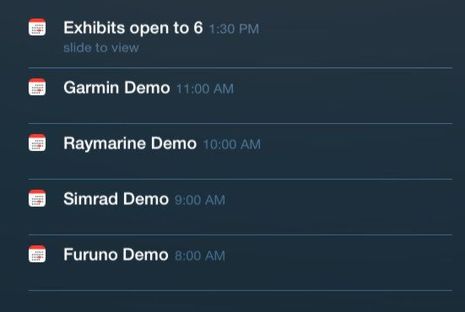NMEA 2011 Technology Award, the pace quickens
The Florida trip was a hell of lot more fun than the virus problems I came home to. For instance, just like last year’s NMEA Technology Award, I got to accessorize my noggin with an interesting gadget (though I’ve worn weirder). In this case it’s a David Clark Co. marine intercom system, which now has a wireless gateway that the company had nominated for the award. To test its claimed 300 foot range, my fellow judge Bill Bishop hiked down to the end of the Expo hall and eventually outside the huge building, all the while chatting with myself and third judge Tim Queeney, all of us in a beautifully noise-cancelled full duplex sonic cocoon. Though it’s quite expensive, Clark really has this technology down. There’s even a virtual lady in there somewhere who tells you when you’ve lost or regained contact with the base station…
Bill, Tim, and I had all studied the thirteen nominated products before we got to Fort Meyers, but we also got to see them in Expo booths, often with expert guidance and Q&A opportunities. At the very beginning, we’d made an agreement to avoid coloring each other’s thinking as we toured the Expo and we started the deliberations process by sharing our individual top three picks. Only one product appeared on all three lists! And though that one product did end up being the winner, we spent a lot of time further contemplating and discussing our collective top five.
That’s real evidence of how competitive this new technology award is. Consider our criteria — Innovation, benefit to boaters, practicality, and value — and then this sterling list of products introduced in the last year: ICOM IC-M24 Handheld VHF, Raymarine e7D Multifunction Display, FLIR First Mate MS Thermal Imaging Camera, Intellian i6W WorldView Marine TV Antenna, KVH TracPhone V3, Geonav G12 Multifunction Display, Sea Tel ST24 Stabilized Marine TV System, SI-TEX SP-110 Autopilot System, Simrad BSM-2 Broadband Sounder, Jeppesen C-MAP 4D Cartography, KEP Marine KEPM GB Dual-Touch Glass Bridge Display Series, and David Clark U9921-GUV Universal Gateway.
I left the winner’s name off that list, just as I saved it, TV-awards-show-style, until the end of my little spiel at the closing NMEA banquet. The press release, which should be online soon, has my fuller quote, but the jist is that the judges felt that we had seen a whole new and valuable marine electronics category in the little Linux server and related apps system known as Digital Yacht’s BOATraNET
Boatranet has come a ways since I wrote about it; it’s now up for NMEA 2000 certification, for instance, and DY seems committed to open sourcing the data flowing from it. But I think it’s safe to say that Nic Heyes was pretty surprised to receive the award, especially given that Digital Yacht came to its first NMEA conference just three years ago. I also heard a lot of enthusiasm about our choice from other manufacturers in the room. I think they all recognize that marine electronics is evolving quickly, just like consumer electronics and other technologies. But I wonder if any of us can see how fast it’s going to get?
I’ve been thinking recently about Ray Kurzweil’s extraordinary theories regarding the exponential growth of technology, and I probably would have yammered about them if I’d had more time before the NMEA crowd. The basic idea is that even though we feel like things are changing fast, we have a hard time conceiving how fast the rate of change is changing. You can read some dense Kurzweil here or watch him at TED here.
But his graph below, which is logarithmic not linear, is a short course. We are moving fast from a world where $1000 worth of computer “equals” the brain power of a mouse to a world where it “equals” that of a human brain. And not far beyond are inexpensive computers with equal the brain power of all humans, and supposedly something called technological singularity, which I gleefully learned yesterday is also known as “the rapture of the nerds”! What I wan’t to know today is when will computer viruses be totally conquered…or will it go the other way, with everything becoming grey goo?
















For non-pilots David Clark may be a new name but they are the “gold standard” in aviation headsets for general aviation, helicopters and military use. I’ve never in 30 years worn a pair out, always upgraded every few years as they came up with new and better designs. Even at 68 and after 3,000+ hours in noisy GA airplanes I can still hear!
There are probably better noise-canceling aviation headsets (especially the kilobuck Bose) but no better or more rugged construction exists. We’re taking a couple along on our sailboat just in case it gets really bad.
Cheers,
Richard D
Ben,
It would be interesting to see a full review of the Boatranet product. It looks like it’s aimed at the “trade” rather than yacht owners. Checking their website, I worry about the quality of their documentation, marketing and sales prowess (although I like their YouTube channel). But if it’s really solid….
“when will computer viruses be totally conquered” Well I haven’t received a computer virus on any of the 3 computers I run daily in, at least, the at least five years…. and two of them I run without a firewall. Of course, none of them run any microsoft software (but they aren’t all Apples either!).
I visited the Cactus Marine (MD) booth at the Annapolis Powerboat Show to see the Digital Yacht Boatranet and AIS products. It was Thursday and raining so it was not busy and we got a great intro and demo of the products. A lot of clever engineering and electronic development going on here.
I too looked at the Digital Yacht Boatranet at the Annapolis Powerboat show. As I understand it, it is a lynix blackbox with a built in web server to display the data from the boat. It shows data from several existing systems including NMEA 2000. the connectivity to iPad, iPhone, etc is pretty nice. I am not sure if it makes sense for me to use Boatranet vs the N2Kview solution which can also show to an iPad/iPhone. The cost of Boatranet is much less than the other solution.
Have not tried the Clark system, but suspect mine is better. I took two Blueant motorcycle intercom/cell systems and mounted them in hollowed out Sony headsets. Got the older non-stereo intercoms so one ear is open to air and the other one listens to the intercom. Full duplex, great voice quality, no wires to a belt-unit, (its small enough to mount on the headset), noise cancelling and really long rechargeable battery life. All it took was a screwdriver, a file and some glue. The intercoms are highly rated by motorcyclists which have a tougher environment then marinas. The headphones were chosen for full over the ear comfort. Great for bike riding as well.
I am equipping a new (used) boat and am coming down to the wire : it’s time to make final purchases of electronics. I bout an Airmar PB200 weather station on the top of the mast, and already display the data with a Furuno N2K display at the wheel. I would also like to see wind & GPS data on my iPad. I keep asking other boat-owners if they have seen Boatranet installed, but never met one. There is lots of literature saying what a lovely concept it is, and I agree, but does it work in practice? Also is it worth the extra money rather than buying a cheaper NMEA-WiFi gateway like the Comar NMEA2wifi?
Once before I bought new electronics because I liked the concept, but always felt I wasted money because it didn’t work well in practice. What has been the field experience?
Dave